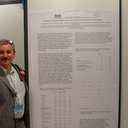[Evaluation of the effectiveness of add-on therapy with tiagabine and evaluation of cognitive functions after application of this therapy in patients with drug-resistant focal epilepsy - an observational study (GABI-EPI)].
کلید واژه ها
خلاصه
OBJECTIVE
To assess the efficacy of add-on therapy with tiagabine and cognitive functions in patients with drug-resistant focal epilepsy, when used in everyday clinical practice.
METHODS
The total number of 437 patients with drug-resistant epilepsy with focal seizures were observed; 436 patients were treated with tiagabine as add-on therapy at a dose of 5-50 mg per day. During the study a number visits were secheduled: Visit V0 - upon enrolment of tiagabine-treated patients into the observational study, visit V1 - four weeks after reaching the initial dose of tiagabine, visit V2 - four weeks after reaching the target dose of tiagabine. The type and number of epileptic seizures, antiepileptic therapy used, concomitant treatment and adverse events were analysed. Analyses were performed using McNemar's, Wilcoxon's, Mann-Whitney's and Fisher's tests. The patients'cognitive functions were assessed using the MM SE scale.
RESULTS
The mean observation time was 90 days. Men accounted for 48.3% of the study population and their average age was 41,5±14,0 and women accounted for 51.7% and their average age was 43.4±13.9. About 80% of the patients received valproic acid or carbamazepine before administration of tiagabine. Other most commonly used drugs included acetylsalicylic acid and ramipril. In the group of 185 patients who used drugs inducing liver enzymes before administration of tiagabine, 13% received a dose below 30 mg of tiagabine and 87% above 30 mg. In the group of patients treated with drugs which do not induce liver enzymes, 91.6% received tiagabine in a dose below 30 mg and 8.4% in a dose above 30 mg. The percentage of patients experiencing epileptic seizures was reduced from 72.2% between visits V0-V1 to 58.7% between visits V1-V2 (p<0.001). A decrease in the population of patients who experienced seizures and a reduction of the number of seizures were observed in all age groups. In the youngest age group, the number of seizures since the last visit went down from 5.4 to 3.7 (the average difference amounted to 1.7), in the 40-59 years age group, the number of seizures went down from 4.0 to 3.1 (the average difference amounted to 0.9) and in patients above the age of 60, from 3.0 to 2.1 (the average difference amounted to 0.9) (p<0.001; p=0.001 and p<0.001, respectively). Adverse events occurred in 4 (i.e. 0.9%) patients, dizziness being the most common. The Mini Mental State Examination (MM SE) was performed in 25% of patients. Cognitive functions did not deteriorate. The average MM SE score corresponded to a mild level of cognitive impairment.
CONCLUSIONS
Tiagabine is a well tolerated drug providing effective control of focal seizures and in a sub-population of 25% patients whose cognitive functions were evaluated using MM SE, no significant adverse effect of the drug on such functions was observed.



